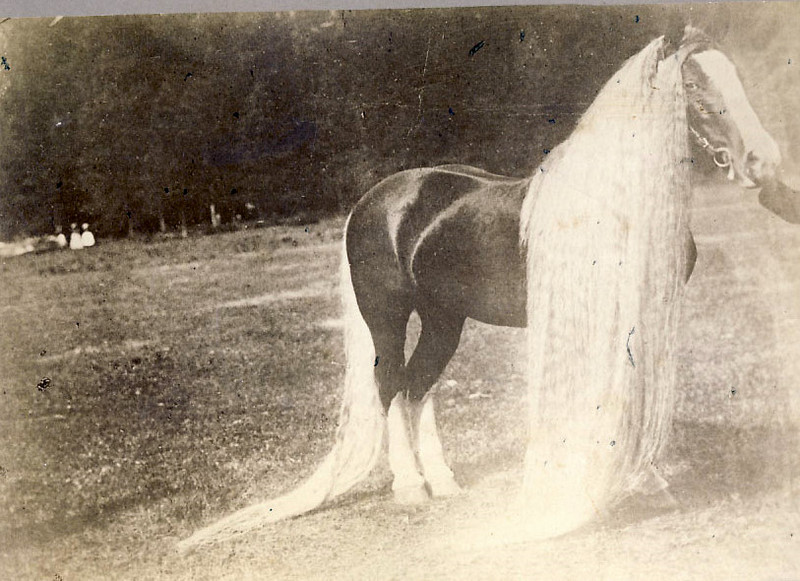
There was a time when the St. Croix Valley was famous for racehorses and its many stock farms. One of these was the Eaton Stock farm which we believe was on the Eaton property near Forest City but was officially listed as being in Calais. The Eatons were the richest family in the area, could well afford to indulge their love for fast horses and owned many well known race horses. In 1891 however they bought Linus, pictured above, and Linus was definitely not a racehorse but he was probably the most expensive horse ever purchased by the Eatons.
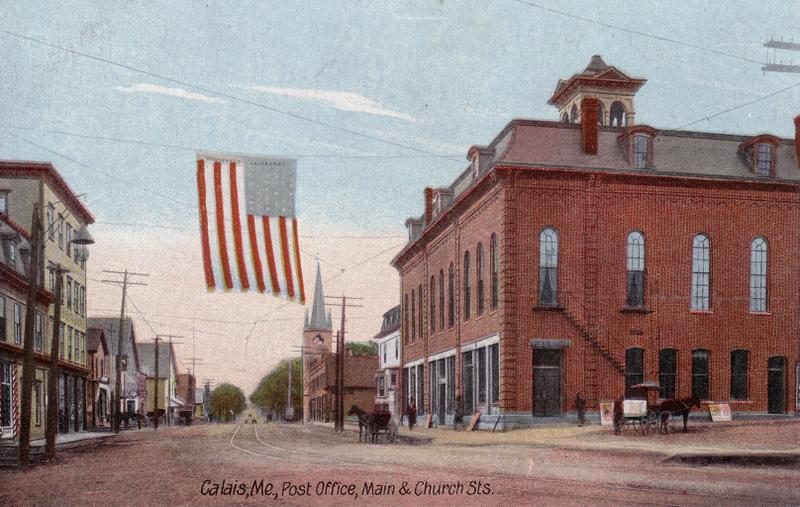
So famous did Linus become that the horse became a Calais celebrity and his photo was displayed at the entrance to the Calais Opera House from the 1890’s until it burned in 1935. We know this photo of the Opera House is 1904 as written across the top of the flag are the names “Roosevelt Fairbanks”. 1904 was the year Teddy Roosevelt was running for President and Fairbanks was his running mate.
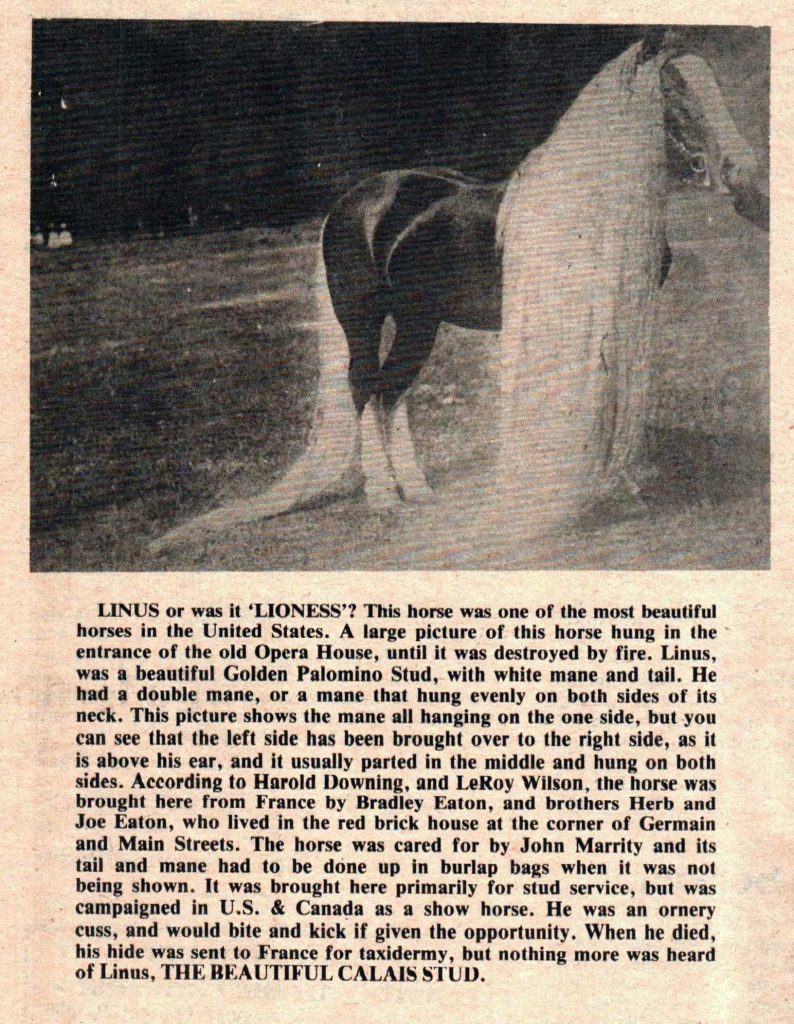
The story behind Eaton’s purchase of Linus has been told before – notably in this old Calais Advertiser article, date uncertain. As is often the case, the information is not entirely correct. Linus was not purchased in France but in Oregon where he was born and raised.
From Breeders Magazine February 7, 1891:
An extraordinary horse has recently been brought to Boston. He is a beautiful golden Chestnut, with light mane and tail, white bind feet, and white face. He is 7 years old, weighs 1435 lbs., stands 16 hands high, and is 3/4 Clyde, 1/8 French, and 1/8 Printer. Linus – that is his name- was born in Marion Oregon on May 28th, 1883 and is considered a perfect and beautiful animal. The fact that at the present time his foretop is 8 ft, mane 8 feet 8 in, and tail 12 ft 3 inches in length, is certainly wonderful and makes him an extraordinary attraction.
No particular care or attention was given to the horse until he was five years old, when his foretop, mane, and tail had increased so much in length that they reached the ground. At this time, his owners commenced to put them in braids and bag them up. Some four months after it was braided the hair was loosened and found to have grown 7 inches. On account of such rapid growth, the owners commenced to cultivate it, and it grew rapidly and at the present time has reached the length mentioned above. In the last 12 months the mane has grown 14 inches and the tail 16 inches and both are still growing.
The horse commenced to attract considerable attention and the owners, the Rutherford Brothers, extensive Oregon cattle dealers, were induced to place him on exhibition in the town of Marion Oregon. Realizing however that the horse was peculiarly adapted for show purposes, and not having any knowledge of this particular line of business, they offered him for sale. Photographs with a horse were sent East, and a copy happening to attract the attention of C.H. Eaton, of the Eaton stock Farm, of Lexington, that gentleman made up his mind to investigate.
The result was that Mr. H.W Eaton made a journey to Marion. One sight of the wonderful equine convinced him of future possibilities, and on behalf of Eaton Brothers he made an immediate purchase of the longest haired ( mane tail and foretop) horse in the known world the price paid was $30,000 cash.
The horse was taken aboard the cars for Boston, and while in transit a stop was made at Albuquerque New Mexico. There a Syndicate offered $50,000 for him which was refused. A further inducement, in the shape of a thousand dollars for a 3-day exhibition, was offered but this was also refused, the trip to Boston was continued and finished after a journey of 27 days. The present owners of the wonder, Eaton and Bros., are both horsemen and are well-known to all owners of thoroughbred stock throughout the United States. They have stock farms at Calais, Me and Lexington, Mass.
$30,000 in 1891 converts to about $850,000 today. We know from other records that the Eatons sold their Lexington Massachusetts stock farm soon after purchasing Linus and brought Linus here where the horse died in 1894, but not before fathering two other beautiful horses: Linus II and Aurelius.
From the website Oregon Wonder Horses:
This original Linus is known to have been three-quarter Clydesdale and one-quarter French (Percheron) and his weight was advertised as 1435 lbs. He was bred in Marion, Oregon, about 1884, then acquired around 1890/91 by brothers CH & HW Eaton from Calais, Maine. Linus was sold to the Eaton Brothers for $30,000 in 1890, but died in 1894 at the age of 10 years. By then, he had sired Aurelius (born Oregon June 1890) and Linus II (born 1894). Aurelius was exhibited at the Egyptian Theatre in Los Angeles as one of the “Oregon Wonder Horses” and was 16 hands tall with “a luxuriant mane and tail”
The Eatons became the most successful promoters of the horse. (Linus)
“When about four years old his mane and tail grew so rapidly-often as much as 3 inches a month -that in three years they reached their present astonishing length. His body colour is a glossy golden chestnut, he has white hind feet and a white face, and his mane, tail and foretop are of a soft flaxen colour. His hair, which is ‘done up’ when he is not receiving visitors, continues to grow, though now very slowly. Linus is certainly a beautiful animal. He is proud, carries his head high, and enjoys admiration with all the intelligence and pride of his race. The mane is 14ft, the foretop 9ft and the tail 12ft. When spread and drawn out to their full extent, the display of the beautiful locks is quite impressive. It is washed out with cold water, no tonics being applied to it.
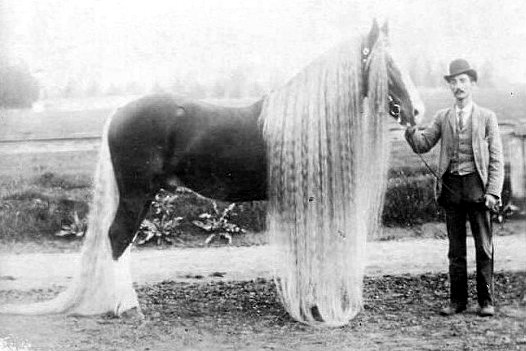
Of Linus’ two offspring, Linus II (shown above) was the more successful show horse, even doing a European tour in 1902.
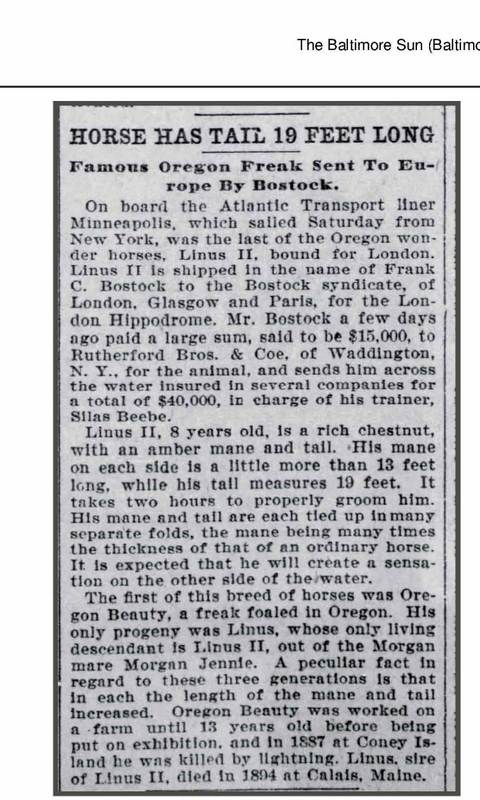
We don’t know when Linus II died, but it appears the Eatons had sold him by the time he traveled to Europe in 1902, and whether they made a profit on either Linus or Linus II we can’t say. By the early 1900s the fortunes of the lumber barons were under pressure from economic changes and the failure of the barons to practice any sort of forest management (even though they had been warned for decades, notably by John Jackson, the editor of the Calais Advertiser, that conservation would serve them better than indiscriminate cutting). Thankfully there was still pulpwood left in the forests. Henry F. Eaton, the patriarch of the family had died long since and the family business soon involved selling off the firm’s vast land holdings. His children and grandchildren didn’t seem to have the business sense of the patriarch and it would not be too harsh to say some were ne’er-do-wells living on family money.
Herbert Eaton murdered his friend Sam Kelley and, thanks to family connections and money, never spent a day in jail; later he was fined $1000 for an unprovoked shooting spree during which he also shot his own brother. The fine was chump change to Herbert, and afterward, Jay Underwood writes:
Herbert Eaton went on to continue his life of wealth, partnering with his brother Charles in the horse ranching business, and earning fame as one of the owners of the legendary Linus II, a massive Oregon-bred three-quarter Clydesdale who stood sixteen hands high, weighed 1,435 pounds and sported a fourteen-foot-long mane and twelve foot-three-inch tail. Linus II was very much like his mother:
this wondrous horse was taken around fairs, show-grounds and museums for many years, showing off her glorious long mane and general good looks. She was a genuine crowd-puller. Until 1887 she gave pleasure to untold numbers of sightseers, before being tragically killed upon being struck by lightning. Luckily, she had produced a son, also named Linus II, and the tradition was able to continue.”
The Eaton brothers were very successful horse traders. In 1890 Charles took “30 or 40” horses from the Calais farm to set up a ranch in Lexington, Massachusetts. He returned a year later, having successfully sold the venture. In the year before his death, the Lewiston Sentinel said of Herbert Eaton that he, “for a number of years owned several of the fastest horses in eastern Maine.”
While Linus, Linus II and even Aurelius are sometimes confused – it was the patriarch of the family Oregon Beauty who was killed by lightning – the Underwood article on Herbert Eaton is quite accurate in its account of Sam Kelley’s 1883 murder, for such it was and not manslaughter as found by the court but this will be the topic on another day
